|
|
Also see Nest ID Matrix (contents) and Egg ID Matrix (color, spots, etc.)
To see other cavity nester bios/photos:
 MOCH nest, photos by Zell Lundberg of Coaldale, CO. It is unusual to see dead oak leaves in nets in CO. Notice distinctive layers. MOCH nest, photos by Zell Lundberg of Coaldale, CO. It is unusual to see dead oak leaves in nets in CO. Notice distinctive layers. |
||
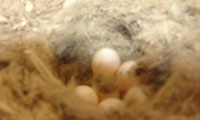 |
||
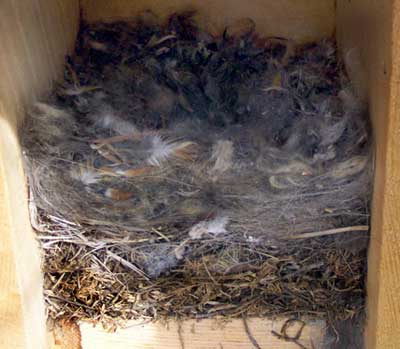 MOCH nest, photo by Claudia Daigle of Santa Fe, NM. Lichen and moss on bottom, with soft, lofty fur layer from a variety of critters on top. The eggs are hidden in a sunken area in the center. Photo below of brooding female (lightened with Photoshop so you can see female). MOCH nest, photo by Claudia Daigle of Santa Fe, NM. Lichen and moss on bottom, with soft, lofty fur layer from a variety of critters on top. The eggs are hidden in a sunken area in the center. Photo below of brooding female (lightened with Photoshop so you can see female). |
||
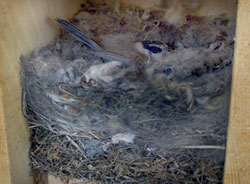 |
||
 MOCH nestlings, photo by Zell Lundberg of Coaldale, CO. About one day old. Looks like 4 or 5 nestlings – there were 6 eggs in the nest. MOCH nestlings, photo by Zell Lundberg of Coaldale, CO. About one day old. Looks like 4 or 5 nestlings – there were 6 eggs in the nest. |
||
 MOCH nestlings, a week later. Tina Mitchell notes “They no longer look like embryonic dinosaurs.” Photo by Zell Lundberg. MOCH nestlings, a week later. Tina Mitchell notes “They no longer look like embryonic dinosaurs.” Photo by Zell Lundberg. |
||
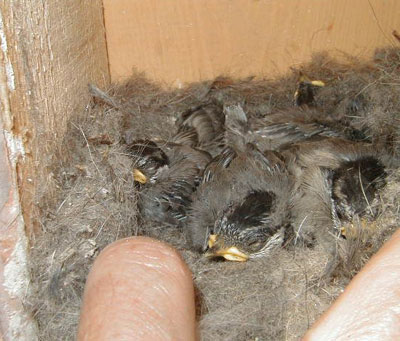 Photos courtesy of Linda Violett. She has had them nest in Big Bear, CA in boxes handing from tree branches 15 feet high, with 1.25″ holes. Photos courtesy of Linda Violett. She has had them nest in Big Bear, CA in boxes handing from tree branches 15 feet high, with 1.25″ holes.
Nest description: of soft materials, with base of rotten wood chips or lichen, moss or grass, topped with loose fur or hair from mammal scat, owl pellets or other sources, (feathers?). Distinct cup molded in fur, then plugged with a blanket of looser fur used to cover eggs when not being incubated. Eggs are ovate, smooth shell with little or no gloss, pure dead white to entirely marked with reddish brown dots which may be concentrated on the larger end. Less heavily marked than Black-capped Chickadee eggs. |
||
 Mountain Chickadee adults. Note distinctive white eyebrow. Mountain Chickadee adults. Note distinctive white eyebrow. |
||
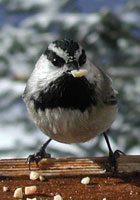 |
MORE INFORMATION & RESOURCES:
The student of Nature wonders the more and is astonished the less, the more conversant he becomes with her operations; but of all the perennial miracles she offers to his inspection, perhaps the most worthy of admiration is the development of a plant or of an animal from its embryo.
-Thomas Henry Huxley, British biologist and educator. Reflection #54, Aphorisms and Reflections, selected by Henrietta A. Huxley, Macmillan, 1907.
